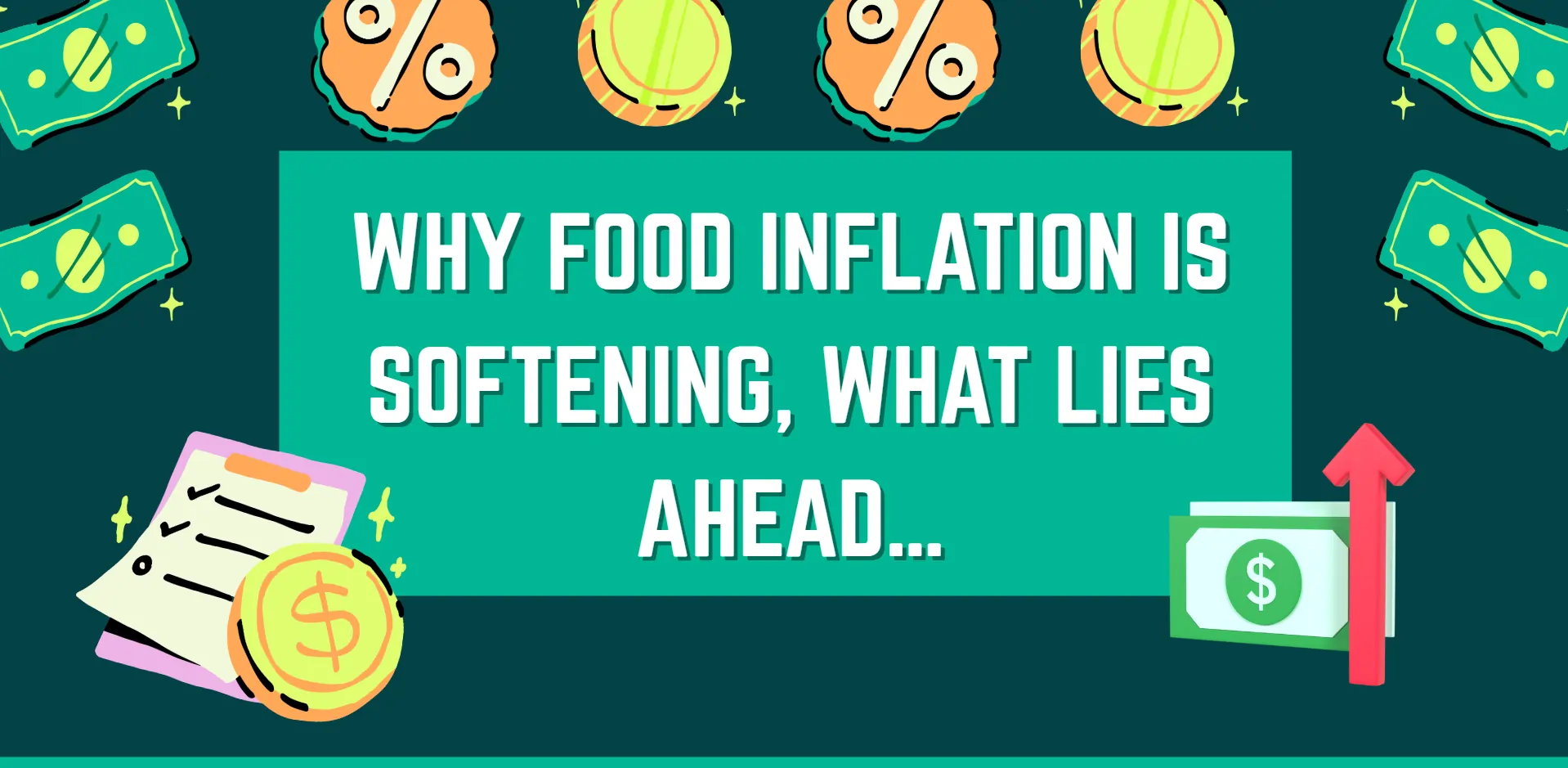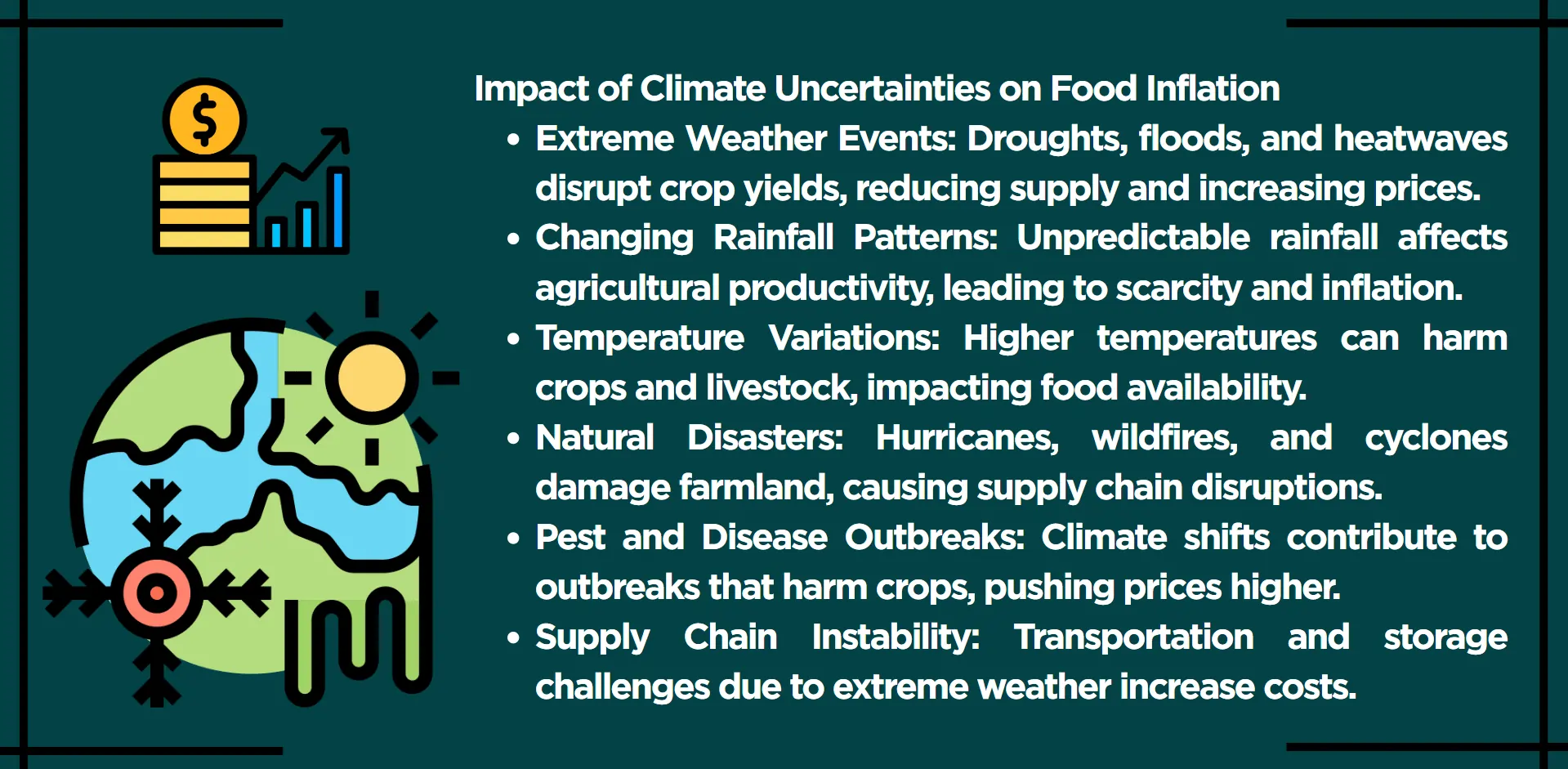The article investigates current food inflation deceleration along with the impact of better agricultural production and policy implementation and examines upcoming challenges that include climate change effects and supply chain breakdowns and financial instability.

Food inflation which serves as an economic health indicator has displayed decreasing trends during the present time thus providing relief to buying customers along with government leaders. The lower prices for grains along with vegetables and dairy products create a substantial change from the prior high prices which affected both households and economies over the past years. Legitimate factors for this pattern include agricultural productivity increases along with restored supply chains and official government policy measures. The price stabilizations create positive expectations yet it remains crucial to evaluate things more deeply. Food price stability remains uncertain because of stormy climate situations, geopolitical instabilities and possible supply chain breakdowns that threaten the future market. The article investigates both the factors and patterns of declining food inflation together with assessing present-day market fluctuations and future food prices to create a thorough understanding of essential economic developments.
Understanding Food Inflation
Food inflation describes the consistent increase in food prices throughout time which creates direct effects on economic stability together with household budgets and societal welfare. Its impacts ripple across individuals, industries, and nations.
Defining Food Inflation and Measurement Metrics
Food inflation refers to the consistent rise in the cost of food items such as grains, fruits, dairy, and meat. Different factors such as inferior supply chain management and weather-related issues and changes in international trade patterns result in this inflation. The Consumer Price Index (CPI) and the Wholesale Price Index (WPI) serve as the main tools for economic measurement of food inflation because they monitor food commodity price changes during specific time periods. The economic and inflationary performance of a nation depends heavily on these evaluations because policymakers primarily use them to determine the state of the economy and develop methods to combat rising costs.

Economic and Social Impacts of Food Inflation
Every component of daily life experiences extensive effects that stem from food price hikes. Consumers must shift more money towards daily necessities when food prices increase and this movement often results in rise of savings funds or flexibility for discretionary purchases. The food and beverage industry together with other businesses need to deal with elevated production expenses and supply chain costs which forces businesses to operate with decreased profit margins or implement increased prices for their customers. Food price inflation maintains as a permanent issue which blocks economic development while making the social divide wider and placing high pressure on government-supported welfare systems.
Historical Episodes of Food Inflation
Studying past events reveals what causes food price inflation to occur. International food prices skyrocketed dramatically between the years 2007-2008 thereby demonstrating this phenomenon to the world. Food prices increased dramatically because of poor crop yields together with rising petroleum prices as agricultural land diverted to biofuel production which made millions impoverished. The COVID-19 pandemic produced soaring food prices because it disrupted supply chains and caused labor scarcity and exceptional challenges to logistics systems. Food systems remain exposed to dangerous external disruptions which include economic, environmental and political disturbances.
Food inflation analysis needs complete comprehension because various embedded causes interact with diverse consequences that explain this phenomenon. Through this understanding stakeholders can better identify the risks and take measures to reduce economic disruption during economic turbulence.
Reasons behind Softening Food Inflation
Various elements working together produced the decrease in food price increases that followed periods of dramatic inflation. Food inflation softening results from various improvements which begin at the agricultural sector and extend to geopolitical changes.
Improved Agricultural Productivity
The major cause of reduced food inflation originates from better farming outputs. An ideal climate combined with better farming methods and no major El Niño events has allowed agricultural production to increase. Precision agriculture together with improved irrigation systems resulted in higher agricultural production. The implementation of resilient seed varieties succeeded in making crops less vulnerable to erratic weather conditions and thus stabilized food market prices through sustained supply.
Global Market Stabilization
Food inflation receives moderation through global factors which contribute significantly to its control. The stabilization of crude oil prices has created an environment of lowered transportation and production expenses which reduces financial burden on agricultural operations. The international trade environment has become more stable due to lower supply chain issues and fewer delivery constraints. The smooth movement of food commodities between different countries has been enabled so consumers can access affordable products.
Effective Government Policies
Food inflation has softened through various policy measures that governments across the world have executed. Government subsidies and storage investments and price control interventions lowered food expenses. Cold storage infrastructure development has reduced food wastage after harvest while expanding fresh product distribution in various markets. Governments have enacted actions to improve farmer market connections which diminish price inflation controlled by middlemen.
Technological Innovations in Supply Chain
Modern technology in the food supply chain created efficiency improvements which eliminated excessive costs caused by system flaws. Modern transportation optimization systems along with inventory control platforms and digital trading platforms have created streamlined paths for food commodity distribution from producers all the way to consumers. The developments create benefits by reducing waste along with enhancing economical distribution of food items.
Multiple forces involving farm sector recuperation combined with worldwide market equilibrium, governmental regulations and technological improvements have jointly eased increased food prices. The analysis depends on continuous monitoring because sudden external disturbances might threaten price stability in the future.
Current Trends and Data
Food inflation experienced significant changes in its patterns because decreasing price trends became evident across the market. This price decline provides comfort to buyers and reveals significant patterns for economic developments.
Recent Decline in Food Inflation
Food inflation rates have decreased according to current statistical findings. The Consumer Price Index (CPI) measures of retail food inflation now stands at levels which have not occurred in many years. The market stabilization of grains and pulses prices results from better production combined with enhanced distribution systems. Fresh produce pricing has stabilized because suppliers now operate more efficient supply chains.

Comparison with Previous Trends
Food prices in the current market demonstrate substantial improvement compared to previous crisis periods including the COVID-19 pandemic but show minimal changes compared to the annual trends. Price records reached unprecedented levels when supply chain breakdowns combined with worker shortages and rising delivery expenses occurred in those times. Food prices have started to demonstrate stability because the previous operational problems were successfully remedied.
Commodities Driving the Change
Food products create the main force behind the price reduction. Wheat together with rice and other fundamental cereals experienced price reductions because of successful harvest seasons combined with government measures. Markdowns on import costs together with higher production levels led to price reductions for dairy products and oils. Spices and exotic fruits make up the exceptions which show limited price changes due to specialized market trends.
Food inflation rates are trending downwards because of these observed trends which create favourable conditions for both industries and households. Stability needs continuous monitoring because of climate risks along with global economic shifts.
Challenges and Risks Ahead
A series of obstacles and potential dangers now endanger the ability of food inflation to remain stable. Several risk factors require specific action so that potential disruptions can be appropriately managed.
Climate Uncertainty
Weather patterns that are difficult to predict represent a leading factor which threatens food price stability. El Niño and La Niña conditions have historically reduced agricultural output by resulting in low crop yields and high production costs. The impacts of climate change intensify severe meteorological events like droughts and floods together with temperature fluctuation which puts strain on the production of crops as well as livestock herds. The absence of sustainable agricultural methods together with resilience plans creates potential for new food price inflation spikes due to climate disturbances.

Supply Chain Vulnerabilities
The global supply chain system remains vulnerable to various types of slowdowns because of political standoffs and transportation hurdles and insufficient workforce. International food commodity transport delays triggered by conflicts in essential trade zones produce price instability for these commodities. Logistical systems including port blockages together with increasing shipping expenses make food distribution slower and increase prices. The reduction of supply chain weaknesses requires both enhanced infrastructure development along with multiple suppliers to mitigate these vulnerabilities.
Economic Instabilities
The financial sector and global marketplace create increased food price instability because of currency exchange rates, interest rate variability and commodity market conditions. When a currency weakens in value it raises import expenses which reduces affordability for fundamental food components. Business operations that experience rising interest rates face increased production and transportation expenses which they can choose to charge to their customers. The unstable economic conditions generate multiple impacts which drive food prices to become unpredictable and unstable.
Technological and Policy Gaps
Modern technologies and policy adjustments softened food price growth yet many potential improvements are still needed. Inadequate access to contemporary farming practices coupled with insufficient funding for scientific research and insufficient policy enforcement serves to block development programs. The wrong implementation of subsidies combined with incorrectly designed price controls produces magnified inflationary effects rather than the intended reduction.
The success of controlling rising food costs depends on resolving current market challenges. Stability can be created through sustainable practices along with strengthened supply chains together with the implementation of sound economic policies.
Future Outlook
The future opens doors for stable price conditions because food inflation shows signs of decreasing. The current situation reveals the immediate need to resolve upcoming challenges when establishing resilient global food systems along with local food systems.
Emphasis on Sustainable Agriculture
Practices of sustainable agriculture will establish themselves as fundamental for sustaining steady food prices. Precise farming together with climate-robust farm produce and environmentally friendly agricultural approaches reduce the effect of environmental uncertainties. Research and development will receive more funding from governments and private businesses as they attempt to boost production levels and lower consumption of unpredictable natural resources.
Technological Advancements
Technology maintains its position as the central force which drives transformations within food supply networks. Artificial intelligence together with block chain and IoT solutions in logistics and inventory management will lead to more efficient operations and waste reduction with optimized costs. Low food inflation rates and consumer price decreases from these technological breakthroughs enhance widespread market accessibility for consumers.
Policy and Global Collaboration
International governments will need to enhance their policy systems to fight against possible inflationary threats. To minimize climate change effects and trade conflicts and supply chain problems worldwide nations must cooperate together. Establishment policies that enhance infrastructure systems and offer farmer subsidies alongside food storage programs help prevent unexpected price spikes.
Anticipating External Risks
The upcoming food inflation looks promising yet continuing surveillance remains important. The three major threats of climate volatility, geopolitical tensions and economic fluctuations continue to persist unabated. Future inflation control requires organizations to take predictive actions alongside developing emergency plans for managing unexpected issues in order to stop inflation triggers.
Food inflation shows promising indications that will continue in the upcoming period. Stability with affordability in the long-term depends on innovative approaches together with collaborative partnerships along with adaptable tactics.
Conclusion
Food inflation has displayed a welcome reduction which benefits both consumers and industry operators because of better agricultural production combined with stabilizing global markets and strategic policy implementations. This reduction of food prices carries specific potential risks. Market stability may come under threat because of uncertainties related to climate patterns together with economic instabilities and disrupted supply chains. The future's success requires sustainable farming techniques combined with strong regulations and creative logistics solutions that enable better nourishment distribution. Stakeholders who address these problems will create a sustainable future with economic stability, food security and price equilibrium.